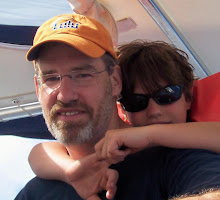We've been hearing a lot about Google's mission lately - to organize the world's information and make it universally accessible and useful.
In Louisville, Kentucky, there is another organization with a very similar mission, except for a rather interesting twist. The organization is the American Printing House for the Blind and their mission is to: To promote the independence of blind and visually impaired persons by providing specialized materials, products, and services needed for education and life.
Since 1858 the American Printing House for the Blind (APH) has been creating unique products for people who are visually impaired, blind, or deaf blind. APH products are designed for infants, preschoolers, students, and adults, both in education and in daily living.
In other words they are trying to organize the worlds information and make it accessible to the sight impaired. In some ways this task is easier than Google's, and in other ways, it is far, far more difficult.
This organization is a little hard to appreciate unless you go visit them. I was in Louisville today for a big status meeting (more on that later), but the more interesting part of the day was a tour of their "printing plant" and their museum. I have visited maybe 20 printing plants in my career, but I've never seen anything, and I mean not even close, to anything that resembles what I saw today.
APH generally (and lets be very liberal here, because they do lots of other products too) takes books that were published by other publishers and creates Braille and/or Large Print editions - on demand - for the sight impaired. Contractually, some of these Braille editions still need to be created on plates, and others can be done electronically. In either case, they need to be translated into Braille first before they can be printed - or I should say imprinted. Braille is essentially an embossing process for every character. Any production person I know will tell you how much embossing just a cover of a paperback book costs. Imagine every character. Each page needs to be printed individually from plates!
The plant is a strange combination of 19th century technology and 21st century technology. There are machines in that plant that I swear are more than 100 years old. All I could think about was the guy whose job it was to keep them running. There were machines in this plant that I have seen only in Antique shops. Yet they were still running, and being run by people who literally endangered their hands every second of their shift.
Then there were sheet fed machines that were were running side by side to create materials (again) one page at a time.
To appreciate this, I want you to imagine a 384 page text book with color illustrations - let's say a high school physics book. Imagine that the reader can't see any of the diagrams. The translator now needs not only to produce the textual translation, but also needs to try and literally interpret and describe the graph or picture. What an incredibly daunting task. I was told of a tragic story today of an AP Physics student who needed a Braille translation, but couldn't get it - and therefore couldn't take AP Physics - because they couldn't find a translator. It wasn't because it was going to cost $30,000 to translate that one book, it was simply that there weren't any translators available who knew physics and braille.
Now, assume that 384 page book could be translated. How many pages is that in braille? I have no idea, but I think a safe assumption would be at least 768. What an unbelievable mission!
This company labors on, under everyone's radar... since 1858.... doing what google has been doing since what? 1998?
We have had the great fortune of have APH as a client for about nine months now, and today we were able to preview the new Louis database portal (which we developed) as well as their new e-commerce site and Title Management database (again a Firebrand product), working together to help the people looking for sight impaired products - find them.
After seeing the incredible job APH has taken on for themselves, our little contribution seems like a pimple on the butt cheek of an organization with an incredible mission. To learn more about APH you can check out their website, or check out the "current" Louis database - but be aware it will be much improved probably around the beginning of next year.
Wednesday, October 29, 2008
Subscribe to:
Post Comments (Atom)

2 comments:
This is good information Fran! We should connect and see what synergies could be created on combining what we are doing with digital conversion to braille files used for braille POD.
The importance of a braille translation being accurate and efficient can indeed not be overstated. Especially in the ever faster moving world of globalized business, successful information and technology transfer within multinational businesses can make the difference between win or lose.
Post a Comment